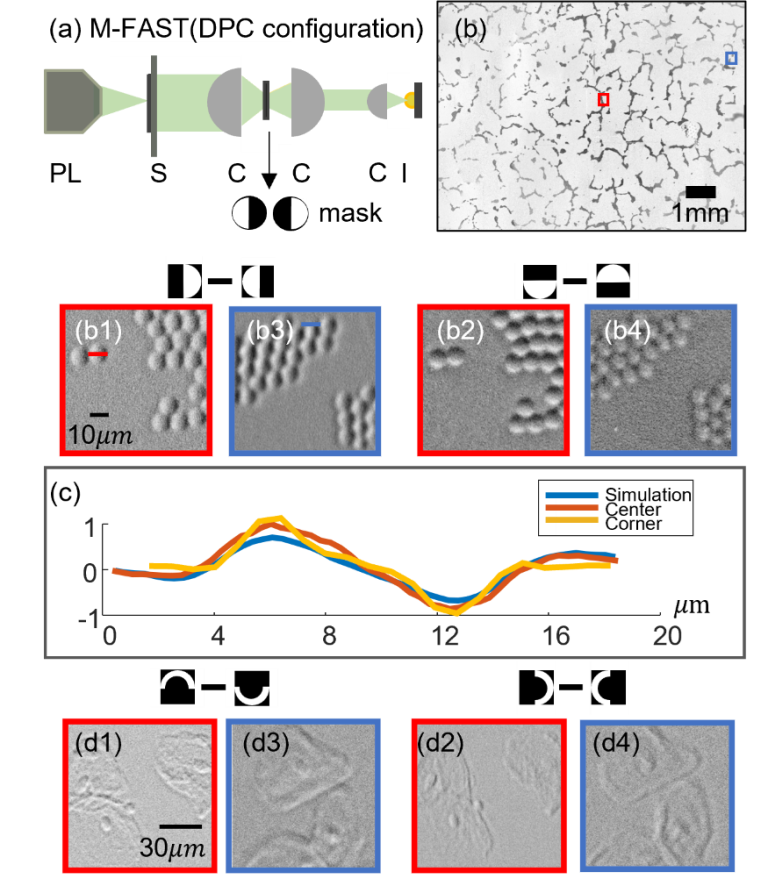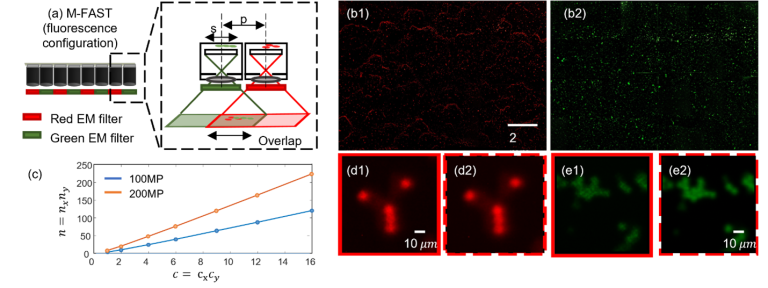Technical Summary of M-FAST 2023
- X. Yang, M. Harfouche, K. C. Zhou, L. Kreiss, S. Xu, K. Kim, R. Horstmeyer, “Multimodal imaging using a cascaded microscope design,” Accepted to Optics Letters (2023). Project Page
High-resolution imaging with a large field-of-view (FOV) is becoming increasingly important in basic research, clinical workflows, and industrial inspection. In particular, imaging complex biological systems demands the use of large FOV microscopes capable of capturing more than hundreds of millions of pixels per snapshot. However, traditional digital microscopes are practically limited by the microscope objective lens and the digital image sensor, which restricts the system’s space bandwidth product (SBP) – the number of resolved pixels per image. The standard approach to increasing the SBP to the gigapixel scale requires expensive giga-pixel sensors and gigapixel throughput lenses.
To overcome this limitation, we propose a cost-effective and scalable solution that uses a multi-camera array microscope (MCAM). Our MCAM can be easily modified to three different imaging configurations, including 20um in Multiview case and 20um in continuous case, as well as 2um in tiled case which requires a scanning process [1]. Our primary goal is to achieve 2um scale resolution in a snapshot imaging mode.
Our proposed design offers two key improvements over prior cascaded imaging system approaches. Firstly, it features a novel optical arrangement that accommodates the use of planar camera arrays, and secondly, it enables multi-modal image data acquisition. Our new “Multimodal Fiber Array Snapshot Technique” (M-FAST) comprises three main components: a primary objective lens, a flat integrated micro-camera array board, and a fiber bundle array plate, as illustrated in the figure below.

Instead of solely relying on the MCAM array for imaging, we introduced a primary lens in front of the MCAM array. This allowed us to capture the image plane introduced by the primary lens and achieve higher magnification. With this configuration, we were able to achieve a FOV of 6.59mm x 9.74mm^2 at a 2.2μm center full-pitch resolution.
However, the primary lens lacked a telecentric design, leading to vignetting issues. To overcome this, we incorporated a fiber faceplate array with an NA = 1 design that accounts for the primary objective lens’ non-telecentricity. This key component effectively solved the vignetting problem.
Furthermore, our system is easily adaptable to differential phase contrast imaging. By inserting an illumination mast in the Fourier plane of the illumination system, we can achieve differential phase contrast imaging. The resulting images are shown below:

We also modify the system to achieve dual-channel fluorescent imaging as described below:

[1]. Harfouche, Mark, Kanghyun Kim, Kevin C. Zhou, Pavan Chandra Konda, Sunanda Sharma, Eric E. Thomson, Colin Cooke et al. “Multi-scale gigapixel microscopy using a multi-camera array microscope.” arXiv preprint arXiv:2212.00027 (2022).
